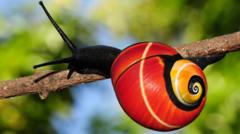Researchers have launched a vital mission to save the critically endangered Polymita snails, renowned for their breathtakingly vibrant and intricately patterned shells, from extinction. Native to Eastern Cuba, these snails are not only considered some of the world's most beautiful creatures but also face severe threats from the illegal shell trade that exploits their allure.
The joint effort brings together scientists from Cuban institutions and experts from the University of Nottingham, aiming to protect the six known Polymita species. Among them, Polymita sulphurosa stands out with its vivid lime green and blue flame patterns, making it especially sought after by collectors.
Prof. Angus Davison, an evolutionary geneticist from the University of Nottingham, emphasizes the paradox of the snails' beauty. While it sparks scientific interest, it simultaneously makes them targets for collectors, increasing their risk of extinction. Recent online searches revealed several UK sellers offering Polymita shells, with prices as high as £160 for collections.
Illegal harvesting of these snails and their shells may further threaten vulnerable species. Although international regulations exist under the Convention on International Trade in Endangered Species, enforcement is difficult. Climate change and deforestation in Cuba compound these threats, putting the snails' survival at greater risk.
In response, Prof. Davison collaborates closely with conservation biologist Prof. Bernardo Reyes-Tur from the Universidad de Oriente in Santiago de Cuba. Their initiative aims to enhance understanding of the snails' evolutionary biology while developing strategies for their conservation.
Prof. Reyes-Tur has taken on the challenging task of rearing Polymita snails in captivity, working in an environment with inconsistent power supply and high temperatures. Although successful breeding has yet to occur, he remains optimistic about their care.
Meanwhile, in Nottingham, extensive genetic research is underway. The team is using cryogenic technology to preserve snail tissue samples, allowing them to decode the animals’ genomic information. This research is critical in determining the number of species, their interrelations, and the genetic factors behind their unique coloration.
As the team races against time, their efforts strive to unveil the biological mysteries of these extraordinary snails before they face further threats from the shell trade. The fate of these vibrant creatures rests in the hands of diligent researchers, who hope to contribute to their conservation and raise awareness about their plight.






















